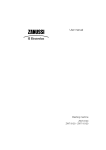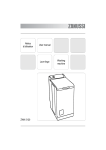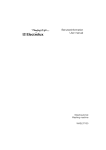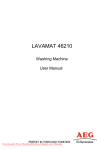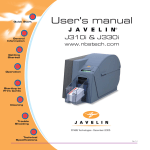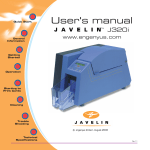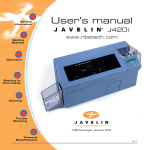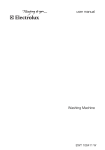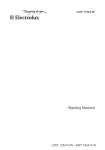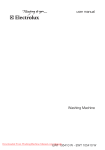Download Electrolux EWT 10320 W User manual
Transcript
User manual Washing machine EWT 10320 W We were thinking of you when we made this product 3 Welcome to the world of Electrolux Thank you for choosing a first class product from Electrolux, which hopefully will provide you with lots of pleasure in the future. The Electrolux ambition is to offer a wide variety of quality products that make your life more comfortable. You find some examples on the cover in this manual. Please take a few minutes to study this manual so that you can take advantage of the benefits of your new machine. We promise that it will provide a superior User Experience delivering Ease-of-Mind. Good luck ! 4 contents Contents Warnings ........................................... 5 Description of the appliance .............. 7 Personalisation .................................. 8 How to run a wash cycle ? ................ 9 Washing guide ................................ 14 Programmes table ........................... 16 Consumption .................................. 17 Care and cleaning ........................... 18 Operating problems ........................ 19 Technical specifications ................... 22 Installation ....................................... 22 Environment .................................... 25 The following symbols have been used in this user guide : Important information about concerning your safety and information on how to avoid damaging the appliance. General information. Information concerning the environment. warnings 5 Warnings These warnings are for the safety of you and others around you. Please read these points carefully before installing and using your appliance. Thank you for your attention. Keep this user manual with your appliance. If the appliance is sold or given to another person, please make sure this user manual is included. This way, the new user will have the relevant operating instructions and warnings. General safety • Do not modify or attempt to modify this appliance. This would put yourself in danger. • Ensure that all coins, safety pins, brooches, screws etc have been removed before starting a washing programme. If left in washing, they can seriously damage the appliance. • Use the amount of detergent recommended in the paragraph “Using the right amount of detergent”. • Put small items together (socks, belts etc.) in a small linen bag or pillow case. • Unplug and close inlet hose tap after using appliance. • Always disconnect the power supply from the appliance before cleaning or maintenance. • Do not machine wash clothes with ribbing, unfinished or torn material. Installation • Unpack or ask for the appliance to be unpacked immediately upon arrival. Check the outside of the appliance is not damaged in any way. Put any complaints you may have in writing on your copy of the delivery receipt. • The appliance must be untied before connecting to power supply or using. If all transit packaging is not completely removed, the appliance or surrounding furniture could be damaged. • Connection to the water supply must be carried out by a qualified plumber. • If your domestic electrical circuit needs adapting to allow the appliance to be plugged in, use a qualified electrician. • Ensure that, after installation, the power cable is not trapped under the appliance. • If the appliance is installed on carpeted floor, ensure that the carpet does not obstruct any ventilation ducts located at the base of the appliance. • The appliance must be equipped with an earthed power plug which conforms to regulations. • Before connecting your appliance to the power supply, carefully read the instructions in the chapter entitled “Electrical connection”. • Replacing the power cable should only be carried out by the After Sales Service. • The manufacturer cannot be held responsible for any damage resulting from incorrect installation. 6 warnings Precautions to be taken against frost If your appliance is exposed to temperatures below 0°C, the following precautions must be taken : • Close the tap and disconnect the inlet hose. • Place the end of this hose and the drain hose in a basin on the floor. • Select the Drain programme let it run until the end of the cycle. • Disconnect the appliance from the power supply by turning the program selector to “Stop”. • Unplug the appliance. • Screw the inlet hose back on and replace the drain hose. This way, the water remaining in the hoses will be drained away, avoiding any ice formation which would damage your appliance. Before turning your appliance on again, ensure that it is installed in an area where the temperature will not fall below freezing. Use • Your appliance is intended for normal domestic use. Do not use the appliance for commercial or industrial purposes or for any purpose other than the one it was designed for : washing, rinsing and spinning. • Only wash items suitable for this treatment. Refer to the instructions on the label of each item. • Do not put items into the washing machine which have had stains removed with petrol, alcohol, trichlorethylne etc. If such stain removers have been used, wait until the product has evaporated before putting these items into the drum. • Your appliance has been designed for use by adults. Ensure children do not touch the appliance or use it as a toy. description of the appliance / personalisation 7 Description of the appliance 1 2 1 The control panel 2 Lid handle 3 Filter access cover 4 Lever for moving the appliance 5 Adjustable levelling feet 3 4 5 Dispenser box Prewash Wash Softener (do not fill above the MAX symbol M ) The control panel 1 Programme selector 2 Pushbuttons and their functions 3 Display 1 4 “Start/Pause” pushbutton 5 “Time Manager” pushbuttons 2 3 4 5 8 description of the appliance / personalisation The symbols 1 Time manager 2 Temperature 3 Child safety 4 Cycle running 5 Length of cycle or Timer delay countdown 8.88 1 2 3 4 5 Personalisation Child safety This option provides two types of locking : - if the option is activated after the cycle has started, no changes to the options or program are possible. The cycle runs and you must deactivate the option to run a new cycle. - if the option is activated before the cycle has started, the appliance cannot be started. To activate child safety, turn appliance on and press “Rinse plus” and “Delay start” simultaneously until the confirmation symbol comes on in the display. The appliance memorises the selection of this option. To deactivate child safety, repeat the process. Audible signal When a button is depressed, an audible signal sounds, at the end of a programme or to indicate a fault. To deactivate, turn appliance on and press “Prewash” and “Rinse plus” simultaneously until the beep sounds. The signal is only active if alarm sounds. To reactivate it, repeat the same process. how to run a wash cycle 9 How to run a wash cycle? Using for the first time • Ensure the electrical and water connections comply with the installation instructions. • Remove the polystyrene insert and all other items inside the drum. • Run an initial wash cycle at 90°C, without any washing but with detergent to clean the water tank. Daily use Loading washing • Open the lid of the appliance. • Open the drum by depressing the locking button A : The two shutters unlock automatically. • Load the washing, close the drum and the lid of your washing machine. Proportioning of detergents Your washing machine has been designed to reduce your water and detergent consumption. You can therefore reduce the amounts recommended by detergent manufacturers. Pour the amount of washing powder into the washing and prewash compartments if you have selected the “prewash” option. Pour fabric softener into the compartment if necessary . If you use another detergent type, refer to the section “detergents and additives” in the washing guide. Selection of desired programme You can find the right programme for different types of washing in the programme table (see “Programme table”). A Before closing the lid of your appliance, ensure that the drum is properly closed : • When the two shutters are closed, • locking button A released. Turn the programme selector to the required programme. The “Start/Pause” pushbutton flashes green. The symbols which correspond to the different stages of the cycle are displayed ( Wash, Rinse, Drain, Spin). If you turn the programme selector to another programme while a cycle is in 10 how to run a wash cycle progress, the appliance will ignore the new selected programme. “Err” flashes and the “Start/Pause” pushbutton flashes red for a few seconds then the current cycle display reappears. At the end of the programme, if you have selected “Rinse and hold” or “Night silence plus” , you then need to select a “Spin” or “Drain” programme to finish the cycle. Selecting the temperature Press the “Temperature” pushbutton repeatedly to increase or decrease the temperature if you want your washing to be washed at a different temperature to the one selected by the appliance. The symbol means a cold wash. “Night silence plus” The washing machine does not empty the water after the final rinse which prevents the washing from creasing. Because there are no spin cycles, the washing programme is very quiet and can be selected at night. In Cotton and Synthetics programmes, the rinsing cycle uses more water. Selecting the spin speed Press the “Spin” pushbutton to change the spin speed, if you want your washing to be spun at a different speed to the one selected by the appliance. You can also select “No spin”*, “Rinse hold”* or “Night silence plus” *. The maximum speeds are : for Cottons, Eco, Jeans, Handwash and Wool : 1000 rpm, for Synthetics, Easy iron, Lingerie and Sport : 900 rpm, for Delicates and Silk : 700 rpm. Selecting options You must select the different options after selecting the programme and before pressing the “Start/Pause” pushbutton (see “Programme table”). Press the desired button(s) ; the corresponding lights come on. If pressed again, the lights go out. If one of the options is not compatible with the selected programme, “Err” flashes on the display and the “Start/ Pause” pushbutton flashes red. “Prewash” option The appliance runs a prewash at 30°C max. The prewash finishes with a short spin cycle for cotton or synthetic programmes, and with an empty cycle for delicates programmes. *depending on model how to run a wash cycle 11 “Rinse plus” option The washing machine will add one or more rinses during the cycle. This option is recommended for people with sensitive skin and in soft water areas. • Temporary : Press the “Rinse plus” pushbutton . The option is only active for the selected programme. • Permanent : Hold down the “Prewash” and “Delay start” pushbuttons for a few seconds. The option is permanently activated, even if the appliance is switched off. To deactivate it, repeat the process. hours to 20 hours. The selected time appears on the display for a few seconds*. You can change or cancel the delayed start time at any time before you press the “Start/Pause” pushbutton, by pressing the “Delay start” pushbutton again (0’ indicates immediate start). If you have already pressed the “Start/ Pause” pushbutton and you want to change or cancel the delayed start, proceed as follows : • To cancel the delayed start and start the cycle immediately, press “Start/Pause” and then “Delay start” . Press “Start/Pause” to start the cycle. • To change the timer delay period, you must go through the “Stop” position and reprogram your cycle. The lid will be locked during the delayed start time. If you need to open it, you must first pause the appliance by pressing the “Start/Pause” pushbutton. After closing the lid again, press the “Start/ Pause” pushbutton. Time Manager “Delay start” option 30’ This option allows you to delay the start of a wash programme by 30, 60, 90, 2 The washing machine will suggest the “Normally soiled laundry” cycle by default. The cycle can be made longer or shorter by using the “Time Manager” **The light does not come on. 12 how to run a wash cycle pushbuttons. The level of soiling of the laundry is also indicated. Heavily soiled laundry Warming up Normally soiled laundry Lightly soiled laundry Very lightly soiled laundry or half load The availability of these different levels varies depending on the selected programme type. Start of the programme Press the “Start/Pause” pushbutton to start the cycle ; the corresponding light will come on green. 2.00 It is normal for the programme selector to remain stationary during the cycle. The symbol for the current cycle and the remaining time appear on the display. 2H If a delayed start has been selected, the countdown appears on the display (hour by hour, then 90, and minute by minute from 60 min). During the cycle, the symbol comes on when the appliance is reaching the right temperature. Interrupting a programme Adding washing When the “Add washing” light is on, you can add washing by proceeding as follows. Press the “Start/Pause” pushbutton : the corresponding light will flash green while the appliance is paused and the message “Pause” is displayed. The lid can only be opened around 2 minutes after the washing machine has come to a stop. Press the “Start/Pause” pushbutton again to continue the programme. Modifying the programme in progress Before making any changes to the current programme, you need to pause the washing machine by pressing the “Start/ Pause” pushbutton. If the modification is not possible, “Err” flashes in the display and the “Start/Pause” pushbutton flashes red for a few seconds. If you still decide to change the programme, you must cancel the current programme (see below). Cancelling the programme If you want to cancel the programme, turn the programme selector to the “Stop” position . how to run a wash cycle 13 End of the programme The washing machine stops automatically ; the “Start/Pause” pushbutton goes out and “0” flashes on the display. The lid can only be opened around 2 minutes after the washing machine has come to a stop. Turn the programme selector to the “Stop” position . Remove washing Unplug and close water inlet tap. We recommend leaving the lid and drum open after use to ventilate the water tank. Standby mode If the appliance is on but no commands are selected for 10 min before or after a cycle, it goes into standby mode. The screen light goes out and “Start/Pause” flashes slowly. To exit standby mode, simply press any pushbutton or turn the programme selector. 14 washing guide Washing guide Sorting and preparing the washing • Sort washing by type and care label (refer to International symbols section below) : normal wash for tough fabrics which can withstand intense washing and spinning cycles ; delicate wash for delicate fabrics which need to be treated with care. For mixed loads, loads with items of different types of material, choose a programme and a temperature suitable for the most fragile material. • Wash whites and colours separately : Otherwise, whites will be coloured or will turn grey. • New coloured clothes often contain excess dye. It is recommended to wash such items separately the first time. Follow care instructions “wash separately” and “wash separately several times”. • Empty pockets and unfold items. • Remove loose buttons, pins and fasteners. Close zip fasteners, tie ups laces and straps. • Turn multilayered fabrics (sleeping bags, anoraks, etc.), coloured headwear, wool and material with printed designs inside out. • Wash small fragile items (socks, tights, bras, etc) in a net bag. • Take special care with curtains. Remove hooks and place net curtains in a net or bag. Wash loads depending on type of materials The amount of washing placed in the drum must not exceed the maximum capacity of the washing machine. This capacity can vary depending on the type of materials. Reduce the quantity if washing is heavily soiled or made of absorbant material. Not all textiles have the same volume in the drum or the same water absorption levels. In general, the drum must therefore be filled : • to full capacity but avoiding excessive pressure on cotton, linen and cotton/linen mixtures, • to half capacity for processed cottons and synthetic fibres, • to a third of its capacity for very fragile items such as net curtains and woollens. For mixed loads, fill drum depending on most fragile materials. Detergents and additives Only use detergents and additives designed for use in a washing machine. Refer to manufacturer’s recommendations and also Dispenser box and Using the right amount of detergent sections. We do not recommend mixing different types of detergents. This may spoil the washing. The amount of detergent to be used depends on the size of the load, the hardness of the water and how heavily soiled the washing is. If the water is soft, reduce the amount slightly. If the water contains lime scale (a descaler is recommended) or if the washing is heavily soiled or stained, increase the amount slightly. washing guide 15 You can obtain information on the hardness level of water in your area by contacting your water company or other competent source. There are no restrictions on the use of powder detergents. Liquid detergents must not be used when a prewash has been selected. For cycles without prewash, they can be added either via means of a dosing ball, or in the detergent compartment. In either case, the wash cycle must be started immediately. Detergent tablets or doses must be placed in the detergent compartment of your appliance’s dispenser box. For stain removal before a wash cycle, please refer to manufacturer’s recommended amounts and instructions. If you use a detergent to remove stains, the wash cycle must be started immediately. International symbols NORMAL WASH Wash at 95°C Wash at 60°C Wash at 40°C Wash at 30°C Hand wash DELICATE WASH BLEACHING Whitewashing (bleach) allowed (cold only and in diluted solution) Do not wash No whitewashing (bleach) IRONING High temperature (max 200°C) Mid temperature (max 150°C) Low temperature (max 100°C) Do not iron DRY CLEANING Dry cleaning (all common solvents) Dry cleaning (all common solvents except trichlorethylene Dry cleaning (only oil-based solvents and R113) Do not dry clean High temperature Mid temperature DRYING Dry flat Hang dry Dry on clothes hanger Tumble drying permitted Do not tumble dry 16 programmes table / consumption Programmes table Programme / Type of washing Load Cottons : White or colour, e.g., normally soiled work clothes, bed linen, table linen, body linen, towels. 5,5 kg Synthetics : Synthetic fabrics, body linen, coloured fabrics, non-iron shirts, blouses. 2,5 kg Delicates : For all delicate materials, for example, curtains. 2,5 kg Easy iron : Reduces creasing and makes ironing easier. 1,0 kg Prewash Rinse plus Delay start Jeans : For washing denim clothes. The Rinse plus option is activated. 3,0 kg Night silence plus Prewash Delay start Spin : A spin cycle from 700 to 1000 rpm after a Rinse hold (or Night silence plus). 5,5 kg Delay start Drain : Runs an empty cycle after a Rinse hold or (Night Silence Plus). 5,5 kg Rinses : Hand washed items can be rinsed in this program. 5,5 kg Lingerie : For very delicate items, like lingerie. 1,0 kg Silk : Fabric machine washable at 30°C. 1,0 kg Possible options Night silence plus Prewash Rinse plus Delay start Time manager Night silence plus Rinse plus Delay start Night silence plus Delay start Handwash : Very delicate items carrying the “wash by hand” label. 1,0 kg Wool : Machine washable wool carrying the labels “pure new wool, machine washable, does not shrink”. 1,0 kg Sport : For dirty outside sport clothes. The Prewash option is activated. 2,5 kg Night silence plus Rinse plus Delay start Eco* : White or colour, e.g., normally soiled work clothes, bed linen, table linen, body linen, towels. 5,5 kg Night silence plus Prewash Rinse plus Delay start * Reference programme for test conforming to CEI 456 standard ( Eco 60° programme). programmes table / consumption 17 Consumption Temperatures Average consumption** °C Litres kWh Cottons cold - 90 63 2,10 Synthetics cold - 60 45 0,80 Delicates cold - 40 50 0,50 Easy iron cold - 60 55 0,45 Jeans 40 55 0,60 Spin - - 0,015 Drain - - 0,002 Rinses - 32 0,05 Lingerie 40 50 0,50 Silk 30 40 0,30 Handwash cold - 40 45 0,45 Wool cold - 40 45 0,45 Sport 40 50 0,70 Eco* 40 - 90 63 1,80 * Reference programme for test conforming to CEI 456 standard ( Eco 60° programme) : 46 L / 0,93 kWh / 140 min ** Average figures which can vary depending on conditions of use. Consumptions shown refer to the maximum temperature for each programme. Time See display Programme Washing type 18 care and cleaning Care and cleaning Drainage filter Clean the filter located at the base of the appliance regularly : 1 2 3 4 5 6 Unplug the appliance before cleaning. Descaling the appliance To descale the appliance, use an appropriate non-corrosive product designed for washing machines. Read product label for recommended amounts and how often descaling should be carried out. The exterior Use warm soapy water to clean the exterior of the appliance. Never use alcohol, solvents or similar products. Dispenser box To clean, proceed as follows : 1 2 7 3 4 Water inlet filters To clean, proceed as follows : 5 6 1 2 operating problems 19 Operating problems Numerous checks were carried out on your appliance before it left the factory. However, should you notice a malfunction, please refer to the sections below before contacting the after-sales service. Problems Causes The washing machine doesn’t start or doesn’t fill : • the appliance isn’t plugged in correctly, the electrical installation isn’t working, • the lid of your appliance and the drum shutters aren’t closed firmly, • the programme start command hasn’t been properly selected, • there is a power failure, • the water supply has been cut off, • the water inlet tap is closed, • the water inlet filters are dirty, • a red tab appears on the water inlet hose. The appliance fills but empties straight away : • the drainage U-piece is fixed too low (see installation section). The washing machine doesn’t rinse or doesn’t empty : • the drain hose is blocked or bent, • the drainage filter is obstructed, • the out of balance detector has been activated : washing is unevenly distributed in the drum, • the “Drain” programme or “Night Silence Plus” option have been selected, • the height of the drainage U-piece is unsuitable. You have found water around the washing machine : • too much detergent has caused foam to overflow, • the detergent is unsuitable for machine washing, • the drainage U-piece isn’t attached correctly, • the drainage filter hasn’t been put back in place, • the water inlet hose is leaking. 20 operating problems Problems Causes Wash is unsatisfactory : • the detergent is unsuitable for machine washing, • there is too much washing in the drum, • the wash cycle is unsuitable, • there isn’t enough detergent. The appliance vibrates, is noisy : • the appliance hasn’t been untied properly (see untying section), • the appliance isn’t level and is unbalanced, • the appliance is too close to the wall or furniture, • washing is unevenly distributed in the drum, • the load is too small. the wash cycle is much too long : • the water inlet filters are dirty, • the power or water supply has been cut off, • the motor overheating detector has been activated, • the water inlet temperature is lower than usual, • the foam detection security system has been activated (too much detergent) and the washing machine has begun draining the foam, • the out of balance detector has been activated : an extra phase has been added to distribute washing more evenly in the drum. The washing machine stops during a wash cycle : • the water or electricity supply is defective • a Rinse hold has been selected, • the drum shutters are open. The lid doesn’t open at the end of the cycle : • the “immediate opening”* light is not lit, • the temperature inside the drum is too high, • the lid unlocks 1 - 2 minutes after the end of the cycle*. The “open drum” light is not on at the end of the cycle : • the drum could not stop in the correct position following an unbalanced spin cycle; turn drum manually. operating problems 21 Problems Causes The E40 error code appears in the display** and the Start/Pause pushbutton flashes red*** : • the lid isn’t closed properly. The E20 error code appears in the display** and the Start/Pause pushbutton flashes red*** : • the drainage filter is obstructed, • the drain hose is blocked or bent, • the drain hose is fixed too high (see “Installation” section). • the drainage pump is blocked, • the standpipe is blocked. The E10 error code appears in the display** and the Start/Pause pushbutton flashes red*** : • the water inlet tap is closed, • the water supply has been cut off. The EF0 error code appears in the display** and the Start/Pause pushbutton flashes red*** : • the drainage filter is obstructed, • the anti-flooding security system has been activated, please proceed as follows : - close the water inlet tap, - empty the appliance for 2 minutes before unplugging, - call the after-sales service. The drainage pump runs constantly, even when the appliance is inactive : • the anti-flooding security system has been activated, please proceed as follows : - close the water inlet tap, - empty the appliance for 2 minutes before unplugging, - call the after-sales service. Softener runs directly into the drum when filling the dispenser box : • you have gone past the MAX indicator. * Depending on model. **On some models, the audible signals can sound. *** After solving any problems, press the ‘Start/Pause’ pushbutton to restart the interrupted programme. 22 technical specifications / installation Technical specifications DIMENSIONS Height Width Depth 850 mm 400 mm 600 mm LINE VOLTAGE / FREQUENCY POWER CONSUMPTION WATER PRESSURE 230 V / 50 Hz 2300 W Minimum Maximum Connection to water supply 0,05 MPa (0,5 bar) 0,8 MPa (8 bar) Type 20x27 This appliance conforms to the CEE 89-336 directive concerning the limiting of radio-electric interference and the CEE 73-23 directive concerning electrical safety. Installation Remove all protective packaging for transit before using for the first time. Keep in case needed for future transit : Transporting a non-secured appliance may damage internal components and cause leakages and malfunctions. The appliance can also be damaged through physical contact. Unpacking 1 2 3 4 5 6 7 8 technical specifications / installation 23 Untying 4 4 3 5 2 1 To install your washing machine at the same level as surrounding furniture, proceed as follows : 5 1 2 Water supply Install the supplied water inlet hose at the rear of your washing machine by proceeding as follows : 1 2 3 4 3 Open the water inlet tap. Check there are no leaks. The water inlet hose can not be extended. If it is too short, please contact the after-sales service. 24 technical specifications / installation Drainage - The connector at 1 the end of the flexible hose can be attached to all common types of standpipe. Attach the connector to the standpipe with the hose clamp supplied with the appliance*. - Fit the U-piece on 2 the drainage hose. Place everything in a drainage point (or in a sink) at a height of between 70 and 100 cm. Ensure it is positioned securely. Air must be able to enter the end of the hose, to avoid any risk of siphoning. Positioning Position the appliance on a flat and hard surface in a ventilated location. Ensure the appliance does not come into contact with the wall or other furniture. To move the appliance, proceed as follows : To move your ap1 pliance, place it on its rollers by pulling the lever located at the base of the appliance hard from right to left. Once the appliance is in the desired position, push the lever back to its original position. Accurate levelling avoids vibrations, noise and prevents the appliance from moving when running. 2 The drain hose must never be stretched. If it is too short, contact a tradesperson. Electrical connection This washing machine must only be connected in single-phased 230 V. Check the fuse size : 10 A for 230 V. The appliance must not be connected with an extension lead or multi-plug adaptor. Ensure that the plug is earthed and that it is in accordance with current norms. * depending on model 3 environment 25 Environment Protecting the environment Disposing of the appliance All materials carrying the symbol are recyclable. Dispose of them at a waste collection site (enquire at your local council) for collection and recycling. When disposing of your appliance, remove all parts which could be dangerous to others: cut off the power supply cable at the base of the appliance. The symbol on the product or on its packaging indicates that this product may not be treated as household waste. Instead it shall be handed over to the applicable collection point for the recycling of electrical and electronic equipment. By ensuring this product is disposed of correctly, you will help prevent potential negative consequences for the environment and human health, which could otherwise be caused by inappropriate waste handling of this product. For more detailed information about recycling of this product, please contact your local city office, your household waste disposal service or the shop where you purchased the product. To save water and energy and therefore help protect the environment, we recommend the following : • Whenever possible, use the appliance at full capacity and avoid partial loads. • Only use the prewash and soak programmes for heavily soiled items. • Use an appropriate amount of detergent for the hardness of the water (cf. section “Using the right amount of detergent”), the size of the load and how soiled the washing is. www.electrolux.com 108 2987 01 - 02/09


























